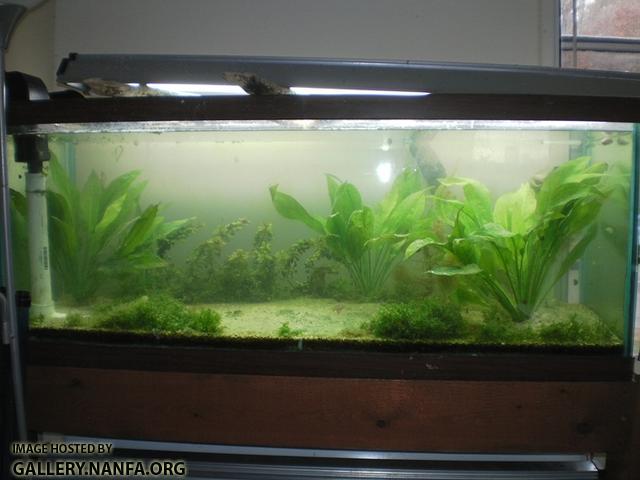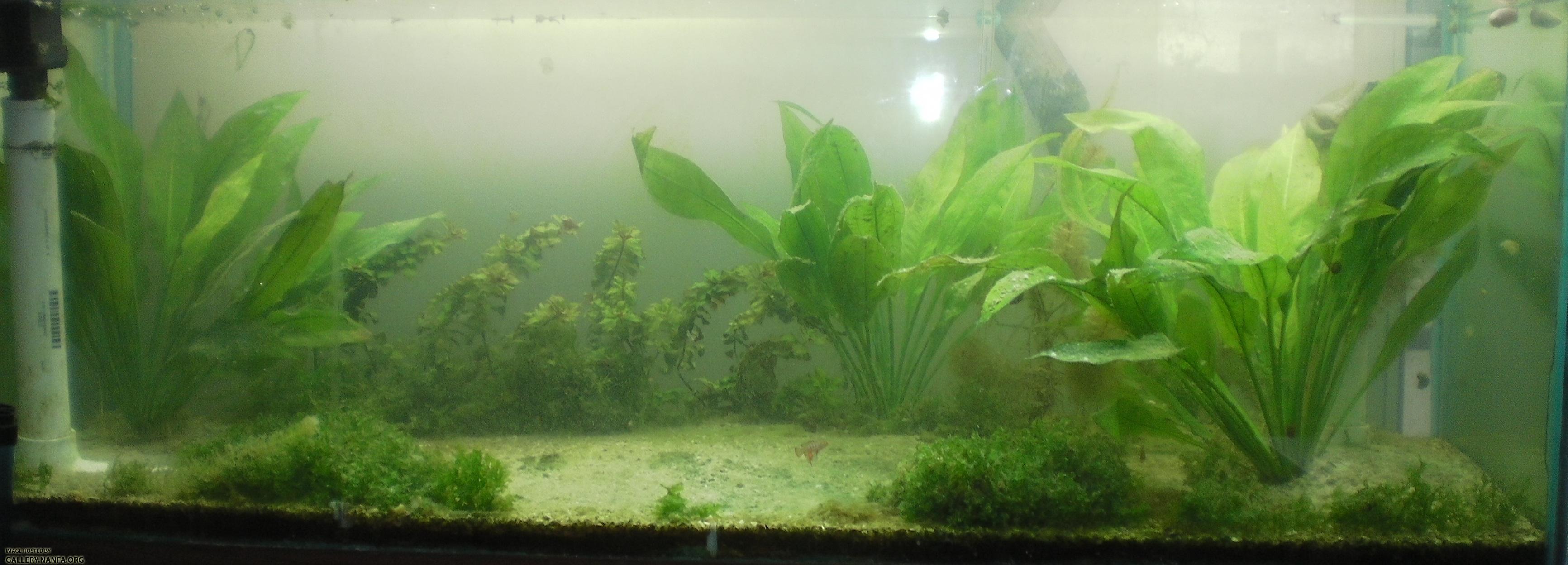Now that they have some spawning sites to defend and lay eggs in and the water's clear, I'll probably start seeing territorial spawning dances soon.
Elassoma gilberti: Round 2!
#41
 Guest_Erica Lyons_*
Guest_Erica Lyons_*
Posted 13 November 2013 - 11:54 AM
Now that they have some spawning sites to defend and lay eggs in and the water's clear, I'll probably start seeing territorial spawning dances soon.
#42
 Guest_Erica Lyons_*
Guest_Erica Lyons_*
Posted 14 November 2013 - 11:48 PM
http://gallery.nanfa...23_001.JPG.html
On a side note, this must be a native species of leech. The worm species origin is from North America and they were farmed in the US. They seem to have eggs underneath their bellies, if anyone cares. They die tomorrow, all hundred thousand of them, so this picture is hopefully all I have of them.
#43
 Guest_Erica Lyons_*
Guest_Erica Lyons_*
Posted 18 November 2013 - 11:39 AM
The dario are out and about now (they've figured out me=grindal worms are coming) but the Elassoma haven't colored up and danced yet. I'm worried that the leeches will eat any eggs before I can siphon them up, but if they're not sensitive to levamisole or fenbendazole I'm not sure what to do about that. It's also worrying that if the leeches get hungry they might attack the fish.
I'm officially regretting ordering the blackworms
#44

Posted 18 November 2013 - 12:53 PM
Do you find them on all surfaces throughout the tank, from top to bottom? Or are they mainly in and amongst the substrate? You are one of the leading experts on Elassoma here and should let your scientist side run rampant here. See what kind of recruitment you get of your Elassoma if you do not rid the tank of the leeches. I would guess that those eggs that are laid on the leaves/vegetation higher up will not get eaten (if they do indeed eat the eggs). The fry may still be quick enough to evade predation from that point on. Or try a feeding experiment. Place a tiny piece of boiled vegetable (a pea for example) next to a pea-sized piece of meat. See which they prefer.
Also, considering the amount of mulm in your tank, you might have just had a population explosion. Let them natually cycle until there is a much smaller population and see what happens.
#45
 Guest_Erica Lyons_*
Guest_Erica Lyons_*
Posted 18 November 2013 - 02:03 PM
Here is a video of one of the leeches eating the blackworms. I observed this several times.
http://www.youtube.com/watch?v=TewMm9LaLc8
I also saw an elassoma dead, looking perfectly healthy except missing part of himself like something'd taken a bite. Maybe he slept too soundly and the leeches got him, I can't say.
"Do you find them on all surfaces throughout the tank, from top to bottom? Or are they mainly in and amongst the substrate?" All over, densest near the bottom. There are some chilling at the filter outflow, snatching food from the current.
"I would guess that those eggs that are laid on the leaves/vegetation higher up will not get eaten (if they do indeed eat the eggs)." Elassoma eggs all fall to the bottom. The one time I saw them up in the plants over the two years I kept them, the eggs had gotten stuck in cladophora algae on their fall down to the ground, and it was very unusual. There's no cladophora in this tank *crosses fingers it stays that way*.
"Let them natually cycle until there is a much smaller population and see what happens." Problem is if they're decreasing in population due to hunger, they may attack my fish and eggs. That's why I wanted to kill them all at once with the dewormer meds, which should theoretically have worked at that dose. I wonder why they didn't. Hmmm.
"Place a tiny piece of boiled vegetable (a pea for example) next to a pea-sized piece of meat. See which they prefer."
They like Ken's golden pearls and blackworms and probably the grindal worms, too. They're not picky, as long as it's got meat.
Ugh, this is awful. I really hate reaching my hand into this tank and coming out with a leech on my skin. It's so gross.
#46

Posted 18 November 2013 - 03:16 PM
I think you are unknowingly on track to manually remove them without even knowing it. Continue to put your hand in there. They'll attach. Remove said hand and repeat.
Have you had success in the past with Panacur and leeches? Formalin might be an option, but your plants will not be happy.
#47
 Guest_Erica Lyons_*
Guest_Erica Lyons_*
Posted 18 November 2013 - 04:45 PM
lolWhat you have in that video is clearly a neonate of one of the aliens from the movie, "They Abyss".
I think you are unknowingly on track to manually remove them without even knowing it. Continue to put your hand in there. They'll attach. Remove said hand and repeat.
Fenbendazole (Panacur) worked on the hydras I had a few months ago. The last time I had leeches, though, I didn't use medication. This was a few years ago when I was still in undergraduate college. Back then I was moving (and breaking down and resetting up the fish tank) twice a year. So I would just dump all my kitty litter substrate in an out of the way place. Then I bought new kitty litter when I got where I was going. That's one of the reason I'm pro-kitty-litter. For nomads like I used to be, being able to toss out your substrate and replacing it for only $7 made breaking down and resetting up tanks much easier. Since this tank's substrate is also kitty litter, I could go that route and just pitch all of this leech infested substrate in the trash. I'm considering that solution, but it might be a little while before I have four hours free to do it.Have you had success in the past with Panacur and leeches? Formalin might be an option, but your plants will not be happy.
#48
 Guest_gerald_*
Guest_gerald_*
Posted 18 November 2013 - 05:25 PM
Erica -- How about siphoning off the top layer of substrate into a bucket with a piece of 5/8" or 3/4" I.D. tubing to remove leeches? You can use chunks of food to lure them into clumps before siphoning.
#49
 Guest_Erica Lyons_*
Guest_Erica Lyons_*
Posted 19 November 2013 - 11:35 AM
Kitty litter doesn't siphon up. It stays down like gravel does.Erica -- How about siphoning off the top layer of substrate into a bucket with a piece of 5/8" or 3/4" I.D. tubing to remove leeches? You can use chunks of food to lure them into clumps before siphoning.
I will try siphoning the leeches off, though. I guess if the water goes into a bucket, any fish that get sucked in might possibly survive.
#50
 Guest_Skipjack_*
Guest_Skipjack_*
Posted 19 November 2013 - 02:43 PM
#51
 Guest_Erica Lyons_*
Guest_Erica Lyons_*
Posted 19 November 2013 - 02:44 PM
They probably eat eggs and might even attack the adult fish.Sounds like these leeches are not a problem. Why not just leave them be?
Also they stick to my arm when I reach in the tank. Ew.
And they burrow, which annoys me 'cause it kicks up dust.
But yeah, I really cannot have them eating eggs.
#52
 Guest_Skipjack_*
Guest_Skipjack_*
Posted 19 November 2013 - 02:51 PM
#53

Posted 19 November 2013 - 02:53 PM
#54
 Guest_Erica Lyons_*
Guest_Erica Lyons_*
Posted 19 November 2013 - 02:54 PM
Very, very likely. Stupid leeches. They're able to burrow, while the hydras weren't.Furthermore, your leeches may burrow into the substrate where, without sufficient cirrculation [through the substrate], the Panacur is unable to reach or effect them.
#55
 Guest_Skipjack_*
Guest_Skipjack_*
Posted 19 November 2013 - 03:07 PM
#56
 Guest_Erica Lyons_*
Guest_Erica Lyons_*
Posted 23 November 2013 - 10:39 PM

http://gallery.nanfa...e size.jpg.html
You can click on this one and zoom in really close to look for little fishies in the plants. There are two dario front and center.
I'm going to have to start using a better camera for these sorts of photos.

http://gallery.nanfa...oom in.jpg.html
They're getting less shy. The dario dario are already spawning-dancing away. Hopefully I'll see some elassoma start at it. There's plenty of room in there for both, I think.
#57
 Guest_Erica Lyons_*
Guest_Erica Lyons_*
Posted 24 November 2013 - 07:45 PM
Instead of just taking a picture, I took a video. The elassoma really do like that pellia. I zoomed in, so if you watch carefully you should see the elassoma head poking out of the pellia. Then it goes and hides. He's a boy, based on his whole body blue stripes. He's not staking territory yet, just hiding in the pellia, but maybe he will soon. There's lots of space to.
#58
 Guest_gerald_*
Guest_gerald_*
Posted 24 November 2013 - 09:26 PM
I've seen some videos of elassoma okefenokee from Germany that show the adult elassoma eating baby brine shrimp, so maybe this will be a way to expand their diet a bit. They do survive solely on grindal worms, yes, and they spawn. But they eat their fry something terrible. Maybe they just like eating their fry. Or maybe that's a sign of nutrient deficiency.
#59
 Guest_Erica Lyons_*
Guest_Erica Lyons_*
Posted 25 November 2013 - 10:52 AM
Interesting side note: the leeches seem to feel compelled to squeeze their way inside this hatchery and die in the high salt region. I had no idea this was going to be a leech death trap. Man, this thing is great
#60
 Guest_Erica Lyons_*
Guest_Erica Lyons_*
Posted 26 November 2013 - 09:11 AM
1 user(s) are reading this topic
0 members, 1 guests, 0 anonymous users








